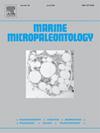Enhanced sedimentary ancient DNA (sedaDNA) retrieval from Antarctic diatoms
IF 1.5
4区 地球科学
Q2 PALEONTOLOGY
引用次数: 0
Abstract
Diatom microfossils are key environmental indicators and an important proxy in paleoenvironmental reconstructions. Sedimentary ancient DNA (sedaDNA) complements microfossil analysis by detecting poorly preserved diatoms and distinguishing morphologically similar taxa, painting a more detailed picture of the past. However, retrieving diatom sedaDNA in marine environments can be challenging due to trace amounts being preserved in the sediment record. Optimising existing protocols is thus essential to maximise diatom sedaDNA yield. This study compares six methods to determine the best approach for recovering diatom sedaDNA from Antarctic marine sediment cores. The same six samples from two sites - U1536C (West Antarctica) and KC02 (East Antarctica), were extracted. Post shotgun sequencing, the methods were evaluated based on diatom sedaDNA recovery, fragment length, and species diversity. Results showed that method performance in retrieving the highest number of Bacillariophyta (diatom) reads is primarily driven by site (R2 = 0.593, p = 0.001) and sample age (R2 = 0.401, p = 0.001), while the extraction method had minimal influence (R2 = 0.001, p = 0.064). The SiMAG method proved highly effective in U1536C but was entirely ineffective in KC02, where the COM Short method successfully recovered diatom sedaDNA. Other methods, including COM QG, PPKIT, and PB, consistently resulted in low sedaDNA yields. Differences in the diversity and the relative abundance of taxonomic classes were also seen across methods (χ2 88.04 to 99,664.17). This study serves as a focal point for experiments aiming to maximise diatom sedaDNA recovery enabling accurate reconstructions of Antarctic marine ecosystems.
从南极硅藻中增强沉积古DNA (sedaDNA)检索
硅藻微化石是古环境重建的关键环境指标和重要代用物。沉积古DNA (sedaDNA)通过检测保存较差的硅藻和区分形态相似的分类群来补充微化石分析,描绘出更详细的过去图景。然而,由于沉积物记录中保存了微量的硅藻sedaDNA,在海洋环境中检索硅藻sedaDNA可能具有挑战性。因此,优化现有方案对于最大限度地提高硅藻sedaDNA产量至关重要。本研究比较了六种方法,以确定从南极海洋沉积物岩心中回收硅藻sedaDNA的最佳方法。从两个地点——U1536C(南极洲西部)和kco2(南极洲东部)——提取了相同的6个样品。霰弹枪测序后,根据硅藻sedaDNA恢复,片段长度和物种多样性对方法进行评估。结果表明,该方法提取硅藻最高reads数主要受位置(R2 = 0.593, p = 0.001)和样品年龄(R2 = 0.401, p = 0.001)的影响,提取方法的影响最小(R2 = 0.001, p = 0.064)。SiMAG方法在U1536C中非常有效,但在kco2中完全无效,其中COM Short方法成功地回收了硅藻sedaDNA。其他方法,包括COM QG、PPKIT和PB,均导致sedaDNA产量较低。不同方法间分类类的多样性和相对丰度也存在差异(χ2 88.04 ~ 99,664.17)。该研究为旨在最大限度地恢复硅藻sedaDNA的实验提供了焦点,从而能够准确重建南极海洋生态系统。
本文章由计算机程序翻译,如有差异,请以英文原文为准。
求助全文
约1分钟内获得全文
求助全文
来源期刊

Marine Micropaleontology
地学-古生物学
CiteScore
3.70
自引率
15.80%
发文量
62
审稿时长
26.7 weeks
期刊介绍:
Marine Micropaleontology is an international journal publishing original, innovative and significant scientific papers in all fields related to marine microfossils, including ecology and paleoecology, biology and paleobiology, paleoceanography and paleoclimatology, environmental monitoring, taphonomy, evolution and molecular phylogeny. The journal strongly encourages the publication of articles in which marine microfossils and/or their chemical composition are used to solve fundamental geological, environmental and biological problems. However, it does not publish purely stratigraphic or taxonomic papers. In Marine Micropaleontology, a special section is dedicated to short papers on new methods and protocols using marine microfossils. We solicit special issues on hot topics in marine micropaleontology and review articles on timely subjects.
 求助内容:
求助内容: 应助结果提醒方式:
应助结果提醒方式:


